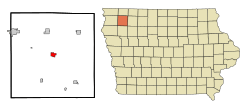Primghar, Iowa facts for kids
Quick facts for kids
Primghar, Iowa
|
|
|---|---|

Location of Primghar, Iowa
|
|
| Country | |
| State | |
| County | O'Brien |
| Government | |
| • Type | Mayor-council |
| Area | |
| • Total | 1.34 sq mi (3.48 km2) |
| • Land | 1.34 sq mi (3.48 km2) |
| • Water | 0.00 sq mi (0.00 km2) |
| Elevation | 1,526 ft (465 m) |
| Population
(2020)
|
|
| • Total | 896 |
| • Density | 667.16/sq mi (257.55/km2) |
| Time zone | UTC-6 (Central (CST)) |
| • Summer (DST) | UTC-5 (CDT) |
| ZIP code |
51245
|
| Area code(s) | 712 |
| FIPS code | 19-64650 |
| GNIS feature ID | 0460449 |
Primghar is a city in O'Brien County, Iowa, in the United States. It is also the county seat, which means it's where the main government offices for the county are located. In 2020, about 896 people lived there. Primghar is located in the northwest part of Iowa. It's about 23.5 miles south of Iowa Highway 9 and 6.75 miles north of Iowa Highway 10.
Contents
History of Primghar
The story of Primghar began because people in O'Brien County wanted to move their county government building, called the courthouse. It was in the very southeast corner of the county, which wasn't convenient for everyone.
In 1872, an election was held to decide where the courthouse should be. Most people voted to move it to the exact center of the county. This spot was just an empty piece of land at the time! It became the future site of Primghar.
The name "Primghar" is quite unique. It was created using the first letter of eight important people who helped plan the town. The current O'Brien County Courthouse building was finished in 1917.
Geography and Landscape
Primghar is located at about 43 degrees North latitude and 95 degrees West longitude. The city covers an area of about 1.38 square miles (3.48 square kilometers), and all of it is land.
Roads and Travel
The main highway that goes through Primghar is U.S. 59, which runs north and south. Another road, B40, crosses the town from east to west. For air travel, there's the Primghar Airport nearby.
Land Features
Primghar sits at an elevation of about 1,520 feet (465 meters) above sea level. This part of northwest Iowa has gently rolling hills. Today, many fields have terraces to help stop soil from washing away. Long ago, when the first settlers arrived, there were very few trees. Instead, tall prairie grass, sometimes as high as six feet, covered the land.
The soil around Primghar is mostly silty clay loam. This type of soil is good for farming. Deeper down, there's a layer of clay loam from ancient glaciers. People once offered a $1,000 reward for anyone who could find coal here, but no one ever claimed the prize.
There's an old rock quarry located a mile south of Primghar. In 1989, the Tjossem family gave it to the city. Now it's called Tjossem Park, a nice place for fishing, picnics, and camping.
Primghar's Climate
Primghar experiences a climate with warm summers and cold winters. The hottest month is usually July, with average high temperatures around 84.6°F (29.2°C). The coldest month is January, with average low temperatures around 9.4°F (-12.6°C).
The area gets a good amount of rain, especially in late spring and summer. June is typically the wettest month. Snowfall is common in winter, with January and December usually seeing the most snow. The weather can change quite a bit throughout the year, from very hot days in summer to very cold days in winter.
Population and People
| Historical population | |||
|---|---|---|---|
| Census | Pop. | %± | |
| 1880 | 143 | — | |
| 1890 | 519 | 262.9% | |
| 1900 | 814 | 56.8% | |
| 1910 | 733 | −10.0% | |
| 1920 | 921 | 25.6% | |
| 1930 | 962 | 4.5% | |
| 1940 | 1,081 | 12.4% | |
| 1950 | 1,152 | 6.6% | |
| 1960 | 1,131 | −1.8% | |
| 1970 | 995 | −12.0% | |
| 1980 | 1,050 | 5.5% | |
| 1990 | 950 | −9.5% | |
| 2000 | 891 | −6.2% | |
| 2010 | 909 | 2.0% | |
| 2020 | 896 | −1.4% | |
| U.S. Decennial Census | |||
In 2020, Primghar had a population of 896 people. The city had 381 households and 237 families. The population density was about 667 people per square mile. Most residents (93.3%) identified as White. About 3.8% of the population was of Hispanic or Latino background.
The average age in Primghar in 2020 was 42.3 years old. About 23.5% of the residents were under 20 years old, and 21.5% were 65 years or older. The population was almost evenly split between males (52.6%) and females (47.4%).
Education in Primghar
Primghar is part of the South O'Brien Community School District. This school district was created in 1993 when three smaller school districts joined together: Paullina, Primghar, and Sutherland. The elementary school for the South O'Brien district is located right in Primghar.
Notable People from Primghar
- Keli McGregor (1963–2010) was a former NFL football player. After his playing career, he became the president of the Colorado Rockies baseball team.
- Rick and Michael Mast are brothers who founded Mast Brothers chocolate, a well-known chocolate company.
- Joseph Welch (1890–1960) was a famous lawyer. He was special counsel for the United States Army during important hearings in 1954. He is remembered for a famous question he asked during those hearings.
See also

- In Spanish: Primghar para niños

